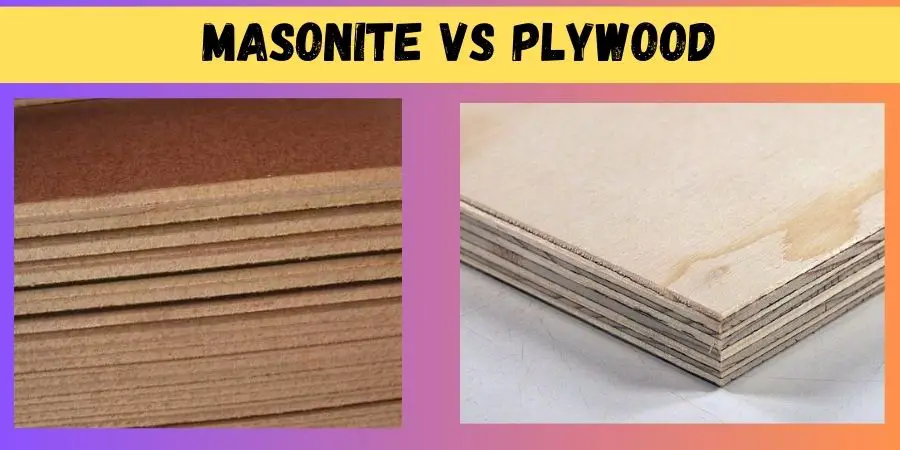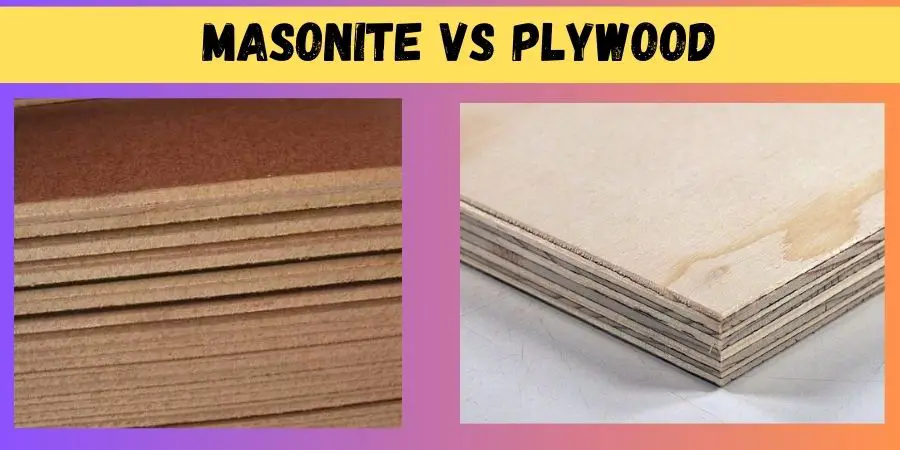In this article, we’ll explore the biggest difference between masonite and plywood, as well as other factors to consider when choosing between the two.
Whether you’re a DIY enthusiast or a professional woodworker, understanding the differences between masonite and plywood can help you make the right choice for your next project.

Masonite: Smooth and Versatile
Masonite is a type of hardboard made from wood fibers that are compressed under high pressure and temperature. It’s known for its smooth surface, which makes it great for painting, printing, and laminating.
Masonite is also relatively lightweight and affordable, making it a popular choice for interior wall paneling, furniture backing, and drawer bottoms.
One downside of masonite is that it’s not very strong or durable compared to other materials, so it may not be suitable for high-impact applications. It’s also not water-resistant, so it’s not recommended for outdoor use or in areas with high humidity.
Plywood: Strong and Sturdy
Plywood, on the other hand, is made by gluing together multiple layers of thin wood veneers, with the grain of each layer running perpendicular to the one above it. This cross-grain construction gives plywood its strength and durability, making it suitable for a wide range of applications.
Plywood comes in different grades and thicknesses, from lightweight and flexible to heavy-duty and rigid. It’s also available in a variety of wood species, including pine, birch, and oak, among others. Plywood is commonly used in construction, flooring, furniture, and cabinetry, among other things.
The main downside of plywood is that it can be more expensive than other materials, especially if you opt for higher-grade plywood or exotic wood species. It can also be heavy and difficult to work with if you’re not using the right tools and techniques.
Masonite vs. Plywood: What’s the Major Difference?
Masonite and plywood may seem similar at first glance, but there are some major differences between the two materials. Here’s a breakdown of the biggest difference:
Composition:
The biggest difference between masonite and plywood is their composition. Masonite is made from compressed wood fibers, while plywood is made by gluing together thin layers of wood veneers.
Why it Matters:
This difference in composition affects the strength, durability, and surface texture of the materials. Plywood’s cross-grain construction makes it stronger and more durable than masonite, while masonite’s smooth surface is better suited for painting and laminating.
Strength and Durability:
As mentioned above, plywood is generally stronger and more durable than masonite due to its cross-grain construction. This makes it a better choice for projects that require a strong and sturdy material, such as construction and furniture-making.
Surface Texture:
Masonite has a smooth surface that’s great for painting and laminating, while plywood has a more textured surface due to the grain pattern of the wood veneers. This makes plywood a better choice for decorative accents such as wall panels or wainscoting.
Price:
Another major difference between masonite and plywood is their price. Masonite is generally less expensive than plywood
Which one should you choose?
The choice between masonite and plywood ultimately depends on your specific needs and the requirements of your project. Here are some factors to consider when making your decision:
Strength:
If you need a strong and durable material for your project, plywood may be the better choice due to its cross-grain construction.
Water Resistance:
If your project will be exposed to moisture or water, plywood may be a better choice, as it is generally more water-resistant than masonite.
Surface Texture:
Consider whether you need a smooth surface or a textured surface for your project. Masonite has a smooth surface that’s great for painting and laminating, while plywood has a more textured surface due to the grain pattern of the wood veneers.
Price:
Masonite is generally less expensive than plywood, making it a popular choice for interior applications and projects where cost is a consideration.
Masonite vs plywood- uses
Masonite and plywood are commonly used for a variety of purposes in construction and woodworking. Here are some common uses for each material:
Masonite:
- Interior wall paneling: Masonite is often used as a backing material for interior wall paneling due to its smooth surface and affordability.
- Furniture backing: Masonite is also used as a backing material for furniture, such as bookcases, cabinets, and dressers.
- Drawer bottoms: Masonite can be used as a sturdy and affordable material for drawer bottoms.
- Painting surface: Due to its smooth surface, masonite is often used as a painting surface for artists and crafters.
- Signage: Masonite is sometimes used for signs, especially for temporary or short-term uses.
Plywood:
- Construction: Plywood is commonly used in construction for sheathing, roofing, subfloors, and more.
- Cabinetry: Plywood is often used in cabinetry, especially for the carcass or frame of the cabinets.
- Furniture–making: Plywood can be used in furniture-making for table tops, shelves, and other components.
- Flooring: Plywood can be used as a subfloor or underlayment for flooring.
- Decorative accents: Plywood can be used to create decorative accents, such as wall panels, wainscoting, and ceiling treatments.





